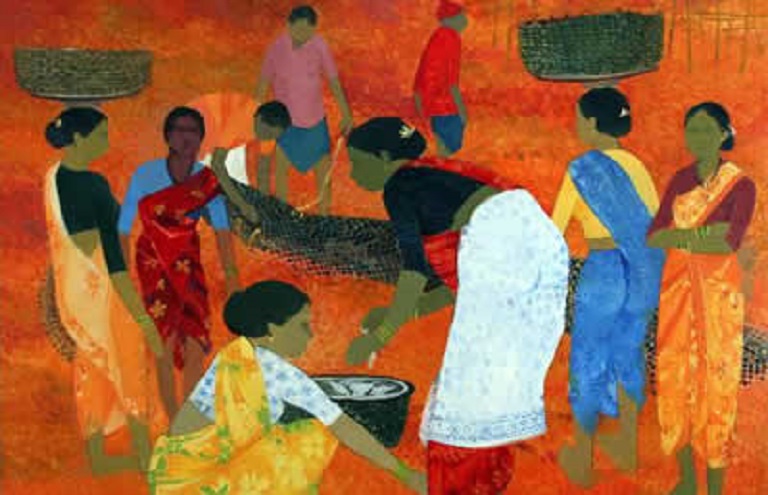Contents
- 1 First Abstract Watercolor, 1910, by Wassily Kandinsky
- 2 Tableau I, by Piet Mondrian, from 1921
- 3 La mancha roja (The red spot), a 1925 work by Joan Miro
- 4 1936 (white relief) Ben Nicholson
- 5 Full Fathom Five, a 1947 painting by Jackson Pollock
- 6 Mountains and Sea by Helen Frankenthaler, 1952
- 7 No. 61 (Rust and Blue), by Mark Rothko, 1953
The aim of the artists to produce works that were unrelated to and unconstrained by visual cues, in reality, gave rise to abstract art. The majority of the 20th century’s most iconic and well-known abstract paintings were produced by artists who looked for and discovered fresh approaches to creating art that would capture the fundamental shifts occurring in Western thought, science, and technology.
The term the genre, which conjures up the idea of being detached or abstracted from something, was used to signify the aim of the earliest abstract painters to liberate their works from the constraints of reality and reflect the imagination in art.
Abstract paintings can take on a number of shapes and styles, and they can either be loosely inspired by real-world objects or completely deviate from them. Colors, patterns, forms, and gestural marks are used in this diverse art form to create a distinctive aesthetic and, frequently, elicit strong emotional reactions from the audience.
Lets learn about some famous abstarct paintings!
First Abstract Watercolor, 1910, by Wassily Kandinsky
Wassily Kandinsky, a painter, made the decision in 1920 to release his works of art from the shackles of their subjects. The creation of the work Untitled (First Abstract Watercolor) marked the beginning of the genre of abstract art. The artwork, which is regarded as the first abstract painting ever created, is characterized by vivid hues and streaks that extend beyond the boundaries of figurative art. Wassily Kandinsky gave colors a special place in his famous abstract paintings work because he saw them as means of expressing emotion rather than as instruments for accurately describing reality.
Tableau I, by Piet Mondrian, from 1921
Eleven years later, abstract artist Piet Mondrian created one of the most well-known abstract paintings that confirmed his signature style, dividing panels of paint with fine black lines. In stark contrast to his ancestors’ passionate, untamed abstract art, his works are distinguished by geometric shapes that are aligned with mathematical precision. The well-known abstract work Tableau I, which only made use of form, color, and line, inspired a wide range of other artists, including architects and fashion designers in addition to the painters and sculptors who came after them.
Going further, you can look in for abstract paintings and buy art online!
La mancha roja (The red spot), a 1925 work by Joan Miro
The painting La mancha roja (The red spot), created by renowned artist Joan Miro, is a joyful, almost childlike, yet frightening work of art that straddles the lines between abstraction and surrealism. The painter, who never really thought of himself as an abstract painter, claimed that on the otherwise hard day, he merely painted the image that was in his thoughts. La mancha roja (The Red Spot), a 1925 painting, opened the way for our visions and dreams to infiltrate the canvas because it was based on subconscious human impulses.
1936 (white relief) Ben Nicholson
Ben Nicholson, one of the most significant practitioners of English Abstraction, started his artistic investigations during the volatile interwar years. Abstraction was a prominent force in art during the period when the world was still rebuilding from World War One while also preparing for World War Two, as a growing number of painters used it as a technique to discover the innocence and purity in the human race. Ben Nicholson combined abstract art, constructivism, and concrete art at the time to produce his 1936 monochromatic, multilayered oil on carved board painting, “White Relief.”
Full Fathom Five, a 1947 painting by Jackson Pollock
The paintings produced by the New York school also offered a far more vibrant concept to the world than those made by abstract painter Ben Nicholson, who was working on pure white cardboard paintings on the other side of the Atlantic and in the abstract art spectre. Jackson Pollock, one of the most well-known abstract artists, and other members of the abstract expressionist movement employed vibrant colours, a range of media, and a unique technique to delve into their subconsciousness. Full Fathom Five painting vividly depicted the post-war worry and added a new degree of texturing to abstract art by using oil paint drips and other materials from the artist’s workshop.
Mountains and Sea by Helen Frankenthaler, 1952
The 1950s, right in the midst of the 20th century, saw a significant impact of Eastern philosophy on abstract art. A new abstract movement known as Color Field Painting was born as a result of painters’ growing interest in Taoism and Zen Buddhism. The goal of colour field painters is to explore the colours without regard to the boundaries of lines, forms, and other painting conventions. The renowned colour field artist Helen Frankenthaler invented the soak-stain technique, which involved pouring oil paint that had been diluted with turpentine straight onto
the canvas. Her paintings would have a very distinct, almost organic feel because the oil paint would seep through the canvas.
No. 61 (Rust and Blue), by Mark Rothko, 1953
Painter Mark Rothko spent almost all of his long and successful career working exclusively with colour, constantly attempting to create a spiritual field on which viewers may experience a range of human emotions. He enhanced the colours in the painting in this particular abstract piece by layering colours, giving it a distinctive brilliance. The painting technique that incorporates both oil-based and egg-based mediums produced this remarkable appearance.

